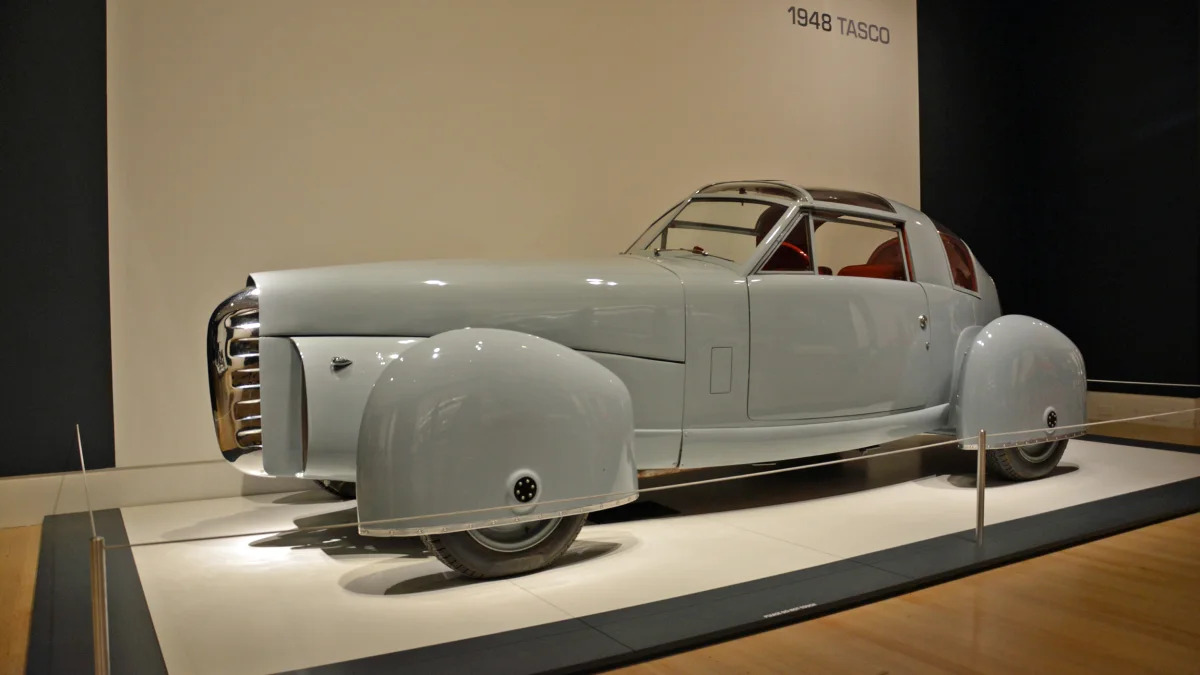One of the Chevrolet Corvette's most popular features traces its roots to an obscure, airplane-like prototype built in 1948. Although the third-generation 'Vette is widely credited as being the first production car equipped with a T-top roof, the system was inaugurated by Gordon Buehrig's one-of-a-kind TASCO prototype and patented in 1951.
Born in 1904, Buehrig was an accomplished stylist and engineer whose resume included the Auburn 851 Speedster, the coffin-nosed Cord 810/812, and several variants of Duesenberg's Model J. Shortly after World War II, he was commissioned by The American Sports Car Company (TASCO) to create — you'll get no points for guessing this — an American sports car. He drew a two-seater with a long hood and a short deck, proportions associated with grand tourers, but he injected an unusually large dose of aerospace DNA into the design.
Vents on either side of the vertical grille directed air to the radiator, and the front wheels were almost completely covered by directional fenders made of molded fiberglass. The TASCO's tapered rear end was also reminiscent of a small plane, but its cleverest feature was a transparent roof that could be removed to let the wind in. This was unheard of in 1948. Buehrig had pegged the TASCO at the intersection of coupes and convertibles.
Sitting in the driver's seat must have felt like stepping into a Cessna because the TASCO featured a tall, shallow, and upright dashboard with about a dozen gauges and a series of levers. The prototype was far less advanced under the sheet metal: The aluminum body built by the Philadelphia-based Derham Body Company was mounted on an extensively modified 1947 Mercury frame, and power came from a regular-production flathead V8.

Although the TASCO is undeniably snazzy in 2020, it was understandably considered far too odd to reach production in 1948. It would have been stunningly expensive to build, too; some estimates pegged its price at $7,500, which represents nearly $80,000 when adjusted for inflation. TASCO quickly abandoned the project, Buehrig's plane on wheels remained a one-off, and he went on to work as a designer for Ford and Lincoln.
The American government granted him patent number US2556062A in 1951, nearly three years after he applied for it. He finally owned the rights to what he had described as a "roof with movable parts" but he chose not to bring it to production while working for Ford. Instead, the third-generation Corvette got the honor of democratizing the T-top roof when it arrived in showrooms as a 1968 model, and Buehrig wasted no time reminding Chevrolet that he was the system's inventor. His patent was still valid (it expired in June 1968), so he sued General Motors — a company he briefly worked for in the late 1920s — over the design and allegedly received a small settlement. In exchange, Chevrolet was allowed to continue building the Corvette with the T-top that fans quickly fell in love with.
Sun worshippers and stargazers quickly realized that, as Buehrig had predicted, the T-top roof provided the best of both worlds (when it didn't leak). Chevrolet later offered it on the Monte Carlo and the Camaro, Datsun fitted it to the 280ZX, Ford made it available in the Mustang, and Toyota's MR2 showed how well it worked in a mid-engined application. In 2020, a sliver of the TASCO's legacy lives on in the eighth-generation Corvette. Its top comes off in one piece, not two, so the separation that made the whole structure shaped like a T is no longer needed. It's not a true T-top like an old Pontiac Firebird's, but the idea is the same. Buehrig would be proud — and sunburned.










Sign in to post
Please sign in to leave a comment.
Continue